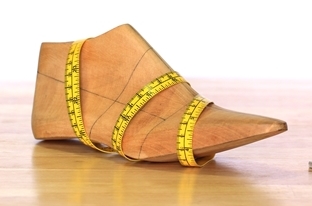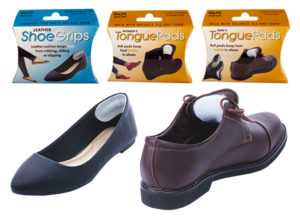Shoes too big for foot contributes to injury

A majority of all people are in shoes that are incorrect shoe size according to Fawn Evenson director of the Footwear Industries of America.
There are two potential errors when selecting what size shoes to wear. Either the shoe will be too small for the foot or too large for the foot. In my experience in the clinic the more frequent mistake I see are clients selecting shoes that are too large for their feet. It is easy to recognize a shoe is too small as it is immediately uncomfortable. It takes time to recognize the shoe is too large.
An explanation for choosing shoes those are too large for a foot is failing to recognize or act on the fact that the width of the foot may not be average. The statistical average shoe width size for men is a D width, and a lady is a B width. A statistical average or median shoe width size means some individuals foot size are greater than a standard deviation wider or narrower than the average shoe width size. Some individuals have skinny long feet; some individuals have short wide feet. If you happen to have less than average foot size particularly width, than you are not going to fit in the average shoe.
Individuals with short wide feet who try to fit in an average width shoe are likely going to select a shoe that is too long for the foot in order to accommodate for the wide foot. This shoe is too large for the relatively short foot. The flex point of the shoe will be in the wrong spot.
Individuals with a long narrow foot who accept an average width shoe are then in a shoe which is too wide for the narrow foot.
There is a relatively easy solution. Ask for a shoe of the appropriate width of your foot size. Unfortunately, not all manufactures will produce shoes of varying widths. Also retail stores often do not stock shoes that are narrow or wide.
Problems wearing shoes that are too large for foot:
Shoes which are too large for foot size can lead to problems.
In my experience this is a contributing factor to development of blisters. Blisters occur because of shearing force. Sliding shearing movement can occur if the shoe is too large for the foot. The same is true for “blood blisters” under the toe nails. The tip of the shoe flexes upward catching the end of the toe nail lifting it away from the toe nail bed.
An interesting study purposely put a group of runners in shoes that were too large for their foot size and measured muscle activity and forces. Shoes longer than the appropriate size resulted in increased in activity of the calf muscles and there was less propulsive force forward. This is consistent with my observation individuals who wear shoes that are too long experiencing Achilles tendon problems.
In my experience shoes that are too large can contribute to pain in the ball of the foot (metatarsalgia). Again it seems a bit counterintuitive buy wearing shoes that are too big or too wide contribute to excessive shearing (side to side movement of foot in shoe). This can also contribute to interdigital neuritis (Moten’s toe syndrome).
Variability in shoe size measurement:
All of the risk for selecting the correct shoe size is on the consumer. Consumers beware.
Shoe sizing can vary from one manufacture to another. Despite standardized labeling of shoe size there is no guarantee that a size 9 Nike shoe is the same as a size 9 New Balance shoe. Each manufacture uses different shoe lasts (foot mold) to construct their shoes. I have even seen shoe sizing variation from a manufacture. Many years ago I had a patient bring two pairs of his size 9 Nike Pegasus running shoes into the clinic. I measured the linear length of both pairs of Nike Pegasus size 9 shoes, and there was an inch and half difference in the length between the two pairs of Nike Pegasus shoes. Shoe manufactures often produce shoes in different countries.
Use of shoe measuring device is a good place to start when selecting what size shoe to wear. This is particularly helpful in identifying the foot width. Absent a shoe measurement tool there are good descriptions available on YouTube describing how to measure your foot/shoe size at home. This is particularly helpful if you shoe shop online. However, the final decision needs a self-assessment of the fit of the shoe on the foot to determine whether the shoe size and shape is appropriate.
Self-assessment of shoe fit:
Rule of thumb: Make sure foot is firmly in back of heel cup of shoe. Using the width of your thumb as a measuring tool, there should be a gap of a width of your thumb from the tip of the longest toe from the front of the shoe.
- Less than a thumb width shoe is too short
- Greater than a thumb width the shoe is too long
- A thumb width the length is just right
To check the fit of the width of a shoe grasp the upper of the shoe at the ball of the foot and squeeze the upper material.
- If there is excessive bunching of the material of the shoe upper the shoe is too wide
- If there shoe upper material is taught unable to grasp material the shoe is too narrow
- If there is a slight amount of bunching of the upper material the width of the shoe is appropriate
With the shoe laces tided comfortably slide a finger down the inside of the ankle. If the finger can touch the bottom of the inner sole of the shoe the heel cup of the shoe is too wide.
Asymmetrical foot size:
Just under half of the population has difference of at least a half shoe sizes between right and left foot. For some foot size difference occurs at the get go. Asymmetrical foot size can occur because of developmental changes before birth, intrauterine. Individuals with scoliosis discovered at adolescences often have asymmetrical foot size. Individuals who injured a joint during their growth spurt as an adolescent will often experience either a growth spurt or stunting of the injured joint, resulting in a structural asymmetry.
The general rule is choosing a shoe to fit the larger foot. This results in the shoe for the smaller foot being too large. This can be addressed by adding padding to the large shoe. A tongue pad shown below is glued to the tongue of the shoe to help ensure a proper fit. Alternatively a pad can be glued to the back of the heel cup making a tighter fit.

Another alternative is to use two shocks on the smaller foot in large shoe. Shoes with laces take time to snug the shoe lacing a little more on the small foot in the large shoe.
Recognize the width of the foot can be an important consideration when selecting the size of shoe.
Damien Howell Physical Therapy – 804-647-9499 – Fax: 866-879-8591 At-Home, At Office, At Fitness Facility, I come to you, I do home visits, or Online Damien@damienhowellpt.com
